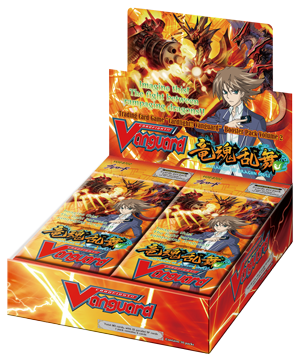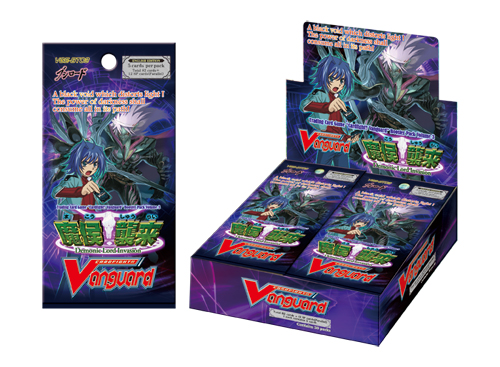Avant d’aborder la préparation du Deck et le vif du sujet, un résumé sur les différents types de « Units » présents dans le jeu. Nous reviendrons sur les différentes particularités plus tard.

II – Le Terrain.
On va commencer par le principal :
– Au centre, le cercle rouge est le cercle du Vanguard.
– Les 5 cercles l’entourant sont les cercles de Rear Guard.
– A gauche, la Damage Zone, où vous entreposerez vos dommages face recto.
– En haut, le demi-cercle vert, c’est la Guardian Zone. Vous y mettrez vos « gardiens » en cas d’attaque. Plus de précisions plus tard.
– La Deck Zone, inutile de vous faire un dessin.
– La Drop Zone, une sorte de Cimetière.
III – Préparer son Deck.
Ensuite, la préparation du Deck. Le Deck doit être composé d’OBLIGATOIREMENT 50 cartes, ni une de plus, ni une de moins. Vous ne pouvez pas avoir plus de 4 exemplaires d’une même carte dans le Deck. De plus, vous devez obligatoirement posséder dans le Deck 16 Triggers Units, ni une de plus, ni une de moins, encore une fois.
Conseil : En ce qui concerne la répartition des grades, en plus de votre Grade 0 que vous utiliserez en tant que Vanguard, essayez un ratio décroissant, du 0 jusqu’au 3. Exemple : 17 ; 14 ; 11 ; 8. Ce n’est bien entendu qu’un exemple.
IV – Conditions de victoire.
Deux moyens, deux uniques moyens de gagner à une partie de Vanguard :
– Infligez 6 points de dommages au Vanguard adverse (voir Damage Zone)
– L’adversaire ne doit plus être en mesure de piocher une carte dans sa Deck Zone.
V – Démarrage du jeu.
1. Préparation de la partie :
Avant toute chose, placez un Grade 0 de votre Deck sur votre zone Vanguard, face cachée. Les joueurs piochent 5 cartes.
2. Mulligan :
Cette règle très sympathique permet de renvoyer des cartes de sa main dans le Deck, le mélanger, et repiocher le même nombre, au cas où si votre main ne vous plait pas.
Entre temps, déterminez au dé ou autre procédé de qui commencera le premier.
3. Stand Up, Vanguard!! :
Déclarez « Stand Up!! » et révélez votre Vanguard.
Note : Le joueur qui choisit de commencer ne peut pas attaquer durant le premier tour.
VI – Déroulement de la partie.
1. Stand Phase :
Placez toutes vos cartes en Rest (position paysage, donc horizontale) en Stand (position portrait, donc verticale).
Note : On dira, pour faire moins compliqué : Engager, pour Rest, et Dégager pour Stand.
2. Draw Phase :
Piochez une carte de votre Deck.
3. Ride Phase :
Vous pouvez placer sur votre Vanguard une Unit dont le Grade est supérieur d’1 ou égal à celui de votre Vanguard.
Vous ne pouvez pas faire plus d’un Ride par tour, excepté si certaines de vos Units vous permettent ce qu’on appelle communément un Superior Ride ou bien une Unit qui vous permet de faire un Ride supplémentaire.
4. Main Phase :
Voici la liste des actions possibles durant cette phase.
a. Call – Appel
Vous pouvez placer une Unit avec un Grade inférieur ou égal à celui de votre Vanguard dans les zones Rear Guard. Vous pouvez faire un nombre de Calls illimité durant votre tour.
NB : Vous pouvez Call une Unit avec un Grade supérieur si un effet de carte vous le propose. Par exemple, « Nightmare Doll, Alice ».
b. Unit Ability – les effets des Units.
Vous pouvez activer n’importe quelle abilité qui vous permettent de le faire en Main Phase. Certaines peuvent et/ou doivent s’activer en Battle Phase.
c. Move – Mouvement
Vous pouvez déplacer une Unit en Rear Guard du haut vers le bas, ou du bas vers le haut. Vous ne pouvez pas déplacer une Unit de la gauche vers la droite et inversement. Vous ne pouvez pas bouger une Unit qui se trouve sous le cercle Vanguard.
5. Battle Phase :
Voici la liste des actions possibles (et dans l’ordre) :
a. Attaquer (merci, Captain Obvious !)
Engagez votre Unit. Vous ne pouvez sélectionner de cibles que des Units qui se trouvent sur la Ligne de Front de l’adversaire.
b. Guardian Call – Appel de Gardiens
Lorsque vous vous faites attaquer, vous pouvez Appeler (Call) un Guardian afin de protéger l’Unit avec son effet Shield (voir les points Shield sur la gauche de la carte). Le Shield s’ajoute au Power du Vanguard jusqu’à la fin du combat. Vous pouvez appeler autant de Guardians de votre choix. Lorsque le combat est fini, tous les Guardians appelés sont envoyés dans la Drop Zone.
c. Drive Check
Lorsque l’Unit qui attaque est un Vanguard (peu importe la cible de l’attaque), vous effectuez un Drive Check.
– Révélez la carte sur le dessus de votre Deck. S’il s’agit d’un Trigger Unit, et que cette Unit est du même clan que le Vanguard ou une Unit placée en Rear Guard, son effet Trigger s’active et se résout. Cette carte est ensuite envoyée dans la main.
d. L’issue de la bataille.
L’attaque est un succès si le Power de l’Unit attaquante est supérieure ou égale à la cible.
– Si la cible était une Unit en Rear Guard, elle est retirée et est envoyée en Drop Zone.
– Si la cible était le Vanguard, calculez le nombre de dommages infligés en comptant la valeur du Critical (1, 2, ou 3 dans les cas extrêmes, les Criticals augmentent par l’effet de skills ou de Critical Triggers)
– Le joueur recevant les dommages envoie la même quantité de cartes sur le dessus du Deck au Cimetière, l’une après l’autre.
– Ainsi, le joueur procède à un Damage Check, et suit la même procédure que le Drive Check.
6. End Phase :
Déclarez la fin de votre tour avant de passer au tour de votre adversaire.
VII – Les Coûts
Le coût est représenté par une icône faite de deux rectangles, blanc et noir, suivie d’un nombre. Il existe différents types de coûts :
(Note : X se réfère au nombre de cartes)
1. Counterblast
Afin d’activer une capacité Counterblast, vous devez flipper face verso des cartes dans votre Damage Zone. La quantité dépend de l’effet.
2. Soul Charge
Le Soul Charge consiste à placer la carte sur le dessus de votre Deck en dessous de la pile de cartes sous votre Vanguard. (La pile est appelée Soul, le Vanguard ne fait pas partie du Soul.)
3. Soul Blast
Le Soul Blast consiste à envoyer un nombre de cartes du Soul à la Drop Zone.
4. Défausser
Il s’agit d’envoyer une ou plusieurs cartes de votre main à la Drop Zone.
5. Engager (Rest)
Engagez l’Unit.
VIII – Explication des icônes
Notes/rappels :
1. Pour qu’un effet de Trigger s’active, vous devez avoir sur le terrain au minimum une Unit du même clan que le Trigger.
2. Un effet de Trigger ne peut pas s’activer de la main.
3. S’il n’y a pas d’icône de Trigger, aucun effet ne se produit.
4. Vous devez choisir l’Unit qui recevra le boost [et/ou l’effet supplémentaire] du Trigger avant de procéder au prochain Drive Check (dans le cas d’une abilité qui vous permet d’en faire plusieurs, comme par exemple le Twin Drive!!)
5. Vous êtes obligés d’activer les effets du Trigger.
—-
1. Effets de Triggers
a. Draw Trigger (Icône rouge : 引)
Lorsque ce Trigger est révélé au cours d’un Drive ou d’un Damage Check, choisissez l’une de vos Unit et celle-ci gagne un bonus de +5000 à son Power, puis vous piochez une carte.
b. Critical Trigger (Icône jaune, motif d’étoile)
Lorsque ce Trigger est révélé au cours d’un Drive ou d’un Damage Check, choisissez l’une de vos Unit et celle-ci gagne un bonus de +5000 à son Power. Choisissez une nouvelle fois une Unit (la même si vous voulez) et elle gagne 1 en Critical.
c. Heal Trigger (Icône verte 治)
Lorsque ce Trigger est révélé au cours d’un Drive ou d’un Damage Check, choisissez l’une de vos Unit et celle-ci gagne un bonus de +5000 à son Power. Si votre nombre de dommages est supérier ou égal à celui de votre adversaire (cette carte exclue), vous pouvez récupérer un point de dommage en remplaçant cette carte avec l’une de vos cartes en Damage Zone. La carte remplacée va en Drop Zone.
Vous ne pouvez pas placer plus de 4 Heal Triggers dans un Deck.
d. Stand Trigger (Icône bleue 醒)
Lorsque ce Trigger est révélé au cours d’un Drive ou d’un Damage Check, choisissez l’une de vos Unit et celle-ci gagne un bonus de +5000 à son Power. Sélectionnez une Unit en Rear Guard et dégagez-la.
2. Effets d’icônes
a. Boost (3 flèches qui pointent vers le haut)
Les Units de Grade 0 et 1 ont cette abilité.
Lorsqu’une Unité déclare une attaque avec un Grade 0 ou 1 derrière, vous pouvez engager cette Unité et ajouter son Power à l’Unité attaquante.
b. Intercept (Symbôle en forme de tic ?)
Les Units de Grade 2 possèdent cette capacité.
Lorsque d’autres Units sont attaquées, vous pouvez déplacer cette Unit en Guardian Zone. Puis, elle est traitée comme si elle avait été appelée en Guardian.
c. Twin Drive!! (Deux flèches qui se croisent)
Les Units de Grade 3 ont cette particularité.
En tant que Vanguard, elles peuvent faire deux Drive Checks.
3. Abilités d’Units
a. [永] = [Continu] : Cette abilité est activée tant que l’Unit est sur le terrain. Vous ne pouvez pas choisir de ne pas l’activer, sauf si c’est précisé.
b. [起] = [Déclenchable] : Cette abilité peut être seulement activée en Main Phase. Vous pouvez choisir de l’activer ou non. Vous pouvez l’activer plusieurs fois sauf si l’inverse est précisé.
c. : Cette abilité est obligatoire et s’activera tant que les conditions seront remplies. Vous pouvez choisir d’activer cet effet ou non, seulement si « Vous pouvez/You may » est écrit dans le texte.
Voilà, tous les détails du jeu n’ont désormais aucun secret pour vous, l’avantage actuellement c’est que vous n’avez pas de rulings pour vous faire ch*er.
Note pour le jeu : Pour des raisons qui font que la situation serait vite en défaveur de l’adversaire, la carte « Barkgal » (Grade 0/Royal Paladin) ne peut pas être utilisée en tant que Vanguard de départ.











.jpg/300px-Vgd_today_(2).jpg)


